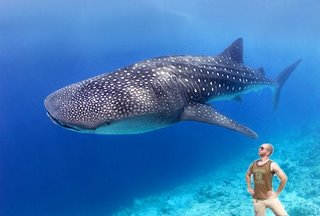Philippines: Raiders of the Lost Butanding

I didn’t have an underwater camera with me, but this is a professional artist rendering of what my adventures with the Butanding may have looked like…
Butanding is a regional word in the Bicol region’s dialect for whale shark. In the waters of Donsol, a small fishing town in the region, whale sharks have been consistently spotted seasonally for the past couple dozen years. As a recent program by Filipino local governments to counteract the illegal hunting of whale sharks for their price-fetching meat, a tourist office for “Whale Shark Interaction” was opened in Donsol about 10 years ago. Basically, you can pay a registration fee and hire an ‘interaction expert’ and crew to go out in the nearby waters and ‘interact’ with the butanding. Since whale sharks only inhabit warm waters near the equator and since their migratory patterns only allow a few months in which they can be easily spotted in a given place, I decided the opportunity was too good to pass up.
After careful research (haphazard Google searching), I came to find that despite their status of “biggest fish in the sea,” they don’t throw their weight around with all their man-eating potential. They’re just plankton feeders. But even being equipped with this knowledge only allows a certain amount of ease once you’re face to face with a creature 6 to10 times your size.
By law (or arbitrary Filipino rule), you have to pay to hire a boat, crew, and a professional “whale shark interaction expert” to guide you and find the butanding. In my mind, I was picturing the professor from Gilligan’s Island with dozens of gadgets to track the water depth, give a heat spectrum of the surroundings, and equip a sonar to listen for the whales’ mating calls, but coming from a lone office in a fishing village off the face of any Philippines map, calling this expectation unreasonable would be like calling the Hundred Years War ‘a little long.’ Our resident expert, Jonathan (every Filipino has an American name) explained the plan, ‘We go to the water, and we look for big shadows.’ That was it. Jonathan took his best Titanic ‘top of the world’ position at the helm of the boat (glorified canoe) and combed the waters. It took only minutes until I heard my first “butanding!” cry from the crew. The captain maneuvered the vessel with the bamboo steering rod the best he could until we were a few dozen meters directly in front of the butanding’s path, and we jumped from the moving boat. The visibility of the water wasn’t too great the day I went out on the boat, so it was difficult to see from underwater where the whale shark would appear. I brought my head up and was about to ask Jonathan where it had gone, but he was already yelling “MMM!!! MMM!!!” through his snorkel and pointing right in front of us underwater, so I put my head back under to see a flat, gigantic face darting straight for me. I may have pissed myself a little, but in the ocean, that’s okay. We moved alongside, and swam beside the whale shark for as long as it would let us before it submerged too far and changed course to lose us. I was about to comment on how huge the fish was, but Jonathan told me ‘that one was a baby, that’s why it moved so fast.’ It was “only” 5 meters big. The next ones we’d find after that were 8, 9, and 10 meters long. They were so big that the polka-dots on their bodies were the size of whiffle balls. They’re known to grow up to 18 meters long.

1 Comments:
Only a Legend could pen such eloquent words as Ernest Hemingway.
Post a Comment
<< Home